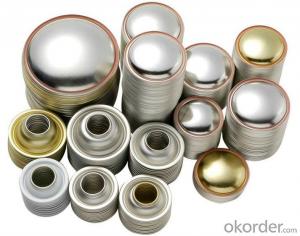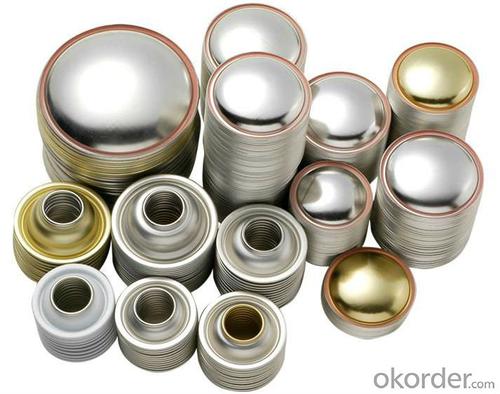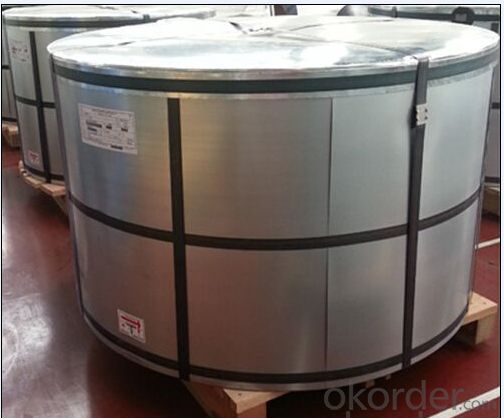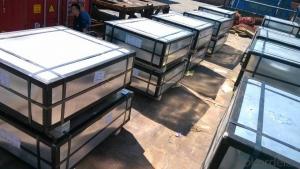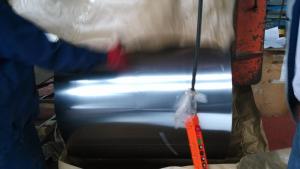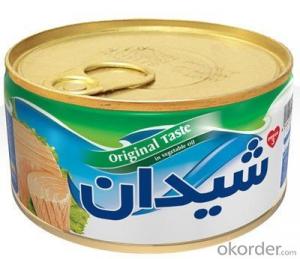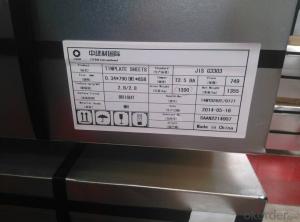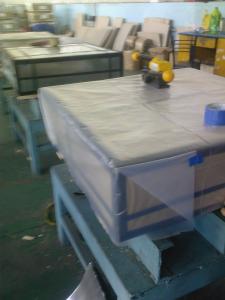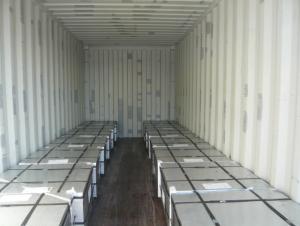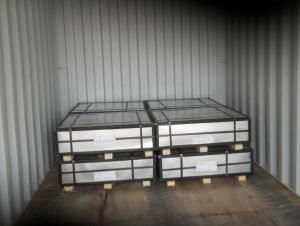Prime Grade Tinplate, Metal Cans Uasge, SPCC/MR
- Loading Port:
- Tianjin
- Payment Terms:
- TT OR LC
- Min Order Qty:
- 25 m.t.
- Supply Capability:
- 40000 m.t./month
OKorder Service Pledge
OKorder Financial Service
You Might Also Like
1.Usage
Tinplate is widely used for making all types of containers, containing industrial usage such as paint can, oil can, aerosol cans etc., and food cans like milk powder cans, tomato paste can, dry food cans etc.
2. Quality
As a state owned company and a large tinplate supplier in China, our tinplate quality ranks 1st level in China, similar to Bao Steel, Posco etc.
3. Specification
standard: GB/T2520, JIS G3303, DIN EN10202
Material: MR /SPCC
Thickness available: 0.16-0.50MM
Width available: 600~1050MM
Temper grade: T1 – DR8
Tin coating: ordinary 2.8g/2.8g, 5.6g/5.6g and others
Package: sea worthy export package.
Applications: Tin can for chemicals & paint cans, industrial cans, food cans
4. our production procedure
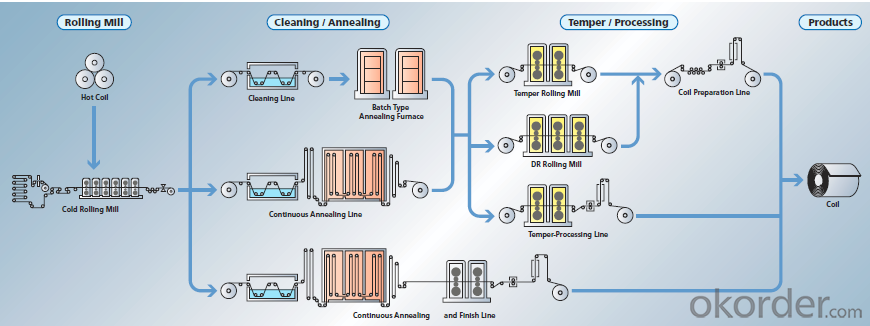
5. usage:
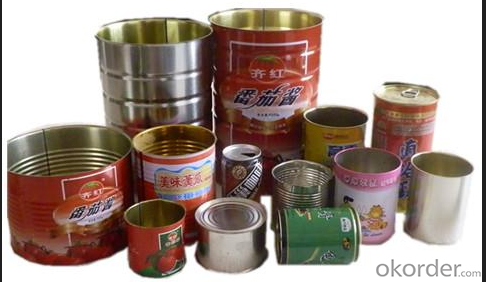
6.export market;
now our tinplate has been sold to more than 30 countries, including Europe countries, Gulf Area, South American, South Afric etc.
7. FAQ
a. what's the annual output?
about 500,000 tons per year.
b. where's the raw matrial from?
our hot rolled coil is purchased from Capital Steel and other state owned mill, with quite good quality.
c. how long is the delivery time?
normally for SPCC about 45~55 days, while 65~75 days for MR material
d. how to control the quality during production process?
inside our workshop, we have MES syestem. It realizes the optimization of the production procedure in the workshop. It could record each step of the whole production procedures, and if some problem appears, factory could easily found and take action, it’s quite helpful to monitor and control the quality.
- Q: How does tinplate contribute to the resistance of marine equipment?
- Tinplate contributes to the resistance of marine equipment by providing a protective coating that prevents corrosion and rusting. The tin layer acts as a barrier, shielding the underlying metal from the corrosive effects of saltwater and other environmental factors, thereby increasing the longevity and durability of the equipment in marine environments.
- Q: Can tinplate be used for packaging liquid products?
- Yes, tinplate can be used for packaging liquid products. Tinplate is a type of steel coated with a thin layer of tin, which provides excellent barrier properties against moisture and oxygen. This makes it suitable for packaging liquids as it helps to prevent spoilage and maintain the product's quality. Additionally, tinplate is also durable and safe for food contact, making it a popular choice for packaging various liquid products such as beverages, oils, and sauces.
- Q: What are the main differences between tinplate and tinplate laminates in terms of design flexibility?
- Tinplate offers limited design flexibility due to its rigid nature, while tinplate laminates provide greater design flexibility as they can be combined with other materials, allowing for more creative and versatile packaging options.
- Q: How does tinplate packaging impact brand image and perception?
- Tinplate packaging can have a positive impact on brand image and perception. Its durability and premium appearance can enhance the perception of the brand, conveying a sense of quality and sophistication. Additionally, the ability to customize tinplate packaging with unique designs and finishes can help brands differentiate themselves and create a memorable impression on consumers. Overall, tinplate packaging can contribute to a positive brand image, reinforcing the brand's values and attracting customers.
- Q: Is tinplate resistant to scratches and dents?
- Yes, tinplate is resistant to scratches and dents.
- Q: How does tinplate packaging contribute to product protection against light?
- Tinplate packaging contributes to product protection against light by providing a durable and opaque barrier. Its metallic properties prevent light from penetrating through the packaging, thus minimizing exposure to UV rays and other forms of light that can degrade the quality and shelf life of sensitive products.
- Q: How does tinplate compare to other packaging materials in terms of sustainability?
- Tinplate is considered to be a highly sustainable packaging material when compared to others. It is infinitely recyclable without losing its properties, making it a preferred choice for many industries. Tinplate also has a lower carbon footprint and energy consumption during its production compared to other packaging materials like plastic or glass. Additionally, tinplate offers excellent protection and preservation qualities, extending the shelf life of products and reducing food waste. Overall, tinplate stands out as a more environmentally friendly option in terms of sustainability in packaging.
- Q: How does tinplate contribute to the convenience of pet care products?
- Tinplate contributes to the convenience of pet care products through its durability, versatility, and ability to preserve the quality and freshness of the products. Tinplate packaging ensures that pet food, treats, and other products remain safe and protected from moisture, light, and oxygen, prolonging their shelf life. Additionally, tinplate cans and containers are easy to open and reseal, providing pet owners with a convenient and hassle-free experience when using these products for their pets.
- Q: How is tinplate coated with organic materials?
- Tinplate is typically coated with organic materials through a process called lacquering or varnishing. The organic coating, usually a resin-based material, is applied to the tinplate surface in a controlled manner, forming a protective layer that prevents corrosion, enhances durability, and provides a decorative finish.
- Q: How does tinplate packaging contribute to product protection against odors?
- Tinplate packaging contributes to product protection against odors primarily through its excellent barrier properties. The tin layer on the surface of the packaging acts as a barrier, preventing the transfer of odors from the outside environment to the product inside. This helps to maintain the product's freshness and quality by effectively sealing off any potential odor contamination.
Send your message to us
Prime Grade Tinplate, Metal Cans Uasge, SPCC/MR
- Loading Port:
- Tianjin
- Payment Terms:
- TT OR LC
- Min Order Qty:
- 25 m.t.
- Supply Capability:
- 40000 m.t./month
OKorder Service Pledge
OKorder Financial Service
Similar products
Hot products
Hot Searches
Related keywords
